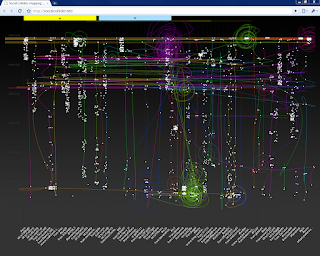This is an experiment in Chrome, so you will need to install the Chrome browser if you do not already have it. You can search for accounts or topics, which are then tracked through time and visualized similar to how a particle collider draws pictures of subatomic matter. After the data mapping is complete, if you hover your cursor over the data point, you will see the information for that data. One amazing visualization is from a search of the topic #epatcon.

Data point particles are mapped two dimensionally based on their position in time (vertical axis) and search query (horizontally). You can search based on user, phrase or trends.
This video shows the basic idea of how it works:
The Social Collider web site explains the experiment like this:
If you have not yet used Social Collider then you should try searching for different names, topics and trends. Go ahead... experiment!The Social Collider reveals cross-connections between conversations on Twitter.
With the Internet's promise of instant and absolute connectedness, two things appear to be curiously underrepresented: both temporal and lateral perspective of our data-trails. Yet, the amount of data we are constantly producing provides a whole world of contexts, many of which can reveal astonishing relationships if only looked at through time.
This experiment explores these possibilities by starting with messages on the microblogging-platform Twitter. One can search for usernames or topics, which are tracked through time and visualized much like the way a particle collider draws pictures of subatomic matter. Posts that didn't resonate with anyone just connect to the next item in the stream. The ones that did, however, spin off and horizontally link to users or topics who relate to them, either directly or in terms of their content.
The Social Collider acts as a metaphorical instrument which can be used to make visible how memes get created and how they propagate. Ideally, it might catch the Zeitgeist at work.
Update - here is some interesting visualization on a search for #w2s:
